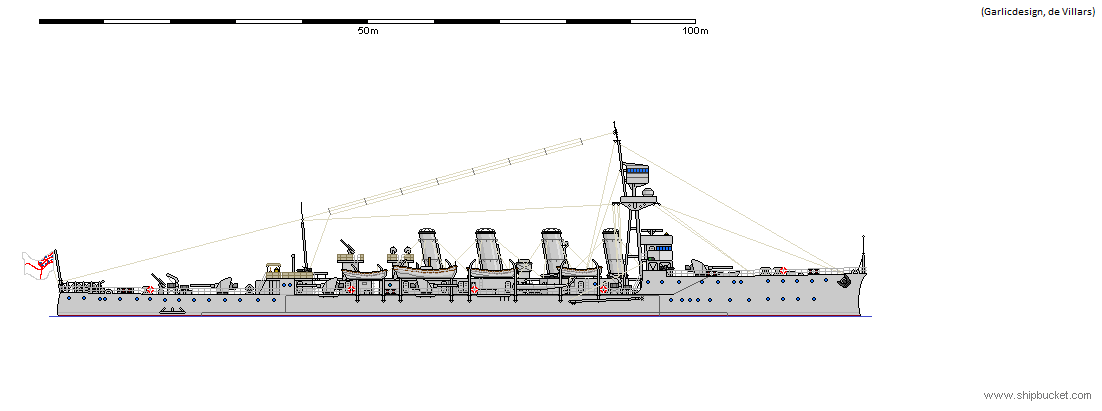Dzisiejszy okręt to odpowiedź na bułgarskie krążowniki prezentowane 25 sierpnia i 15 września 2024 r. Ten okręt, w założeniu jest mini-Scharnhorstem. Jest oczywiście niemieckiej budowy i posiada ujednolicone uzbrojenie artyleryjskie w postaci 8 dział kal. 17 cm L/40 (takich jak na pancernikach typu Deutschland i Braunschweig). Ich rozmieszczenie jest podobne do wspomnianego niemieckiego krążownika pancernego – 4 działa znajdują się w wieżach na dziobie i rufie, a pozostałe 4 – w kazamatach na śródokręciu. Okręt ma wyporność limitowaną do niespełna 7000 ton, w ramach której udało się uzyskać opancerzenie o grubości 150 mm na burtach, 150 mm na wieżach i 100 mm na kazamatach, prędkość wynoszącą 22 w. i zasięg 5100 Mm. Są to parametry, jak się wydaje, wystarczające jak na przeznaczenie okrętu, tj. do działań na wodach okalających Turcję – Morzu Czarnym, Egejskim i Śródziemnym przeciw krążownikom bułgarskim (ww., hipotetyczne), rosyjskim czy greckim (hipotetyczny typ Antinavarhos Kontouriotis – post z 19 stycznia 2024 r.).
Mukkademe-i Hayir, turkish armoured cruiser laid down 1906 (Engine 1907)
Displacement:
6 091 t light; 6 363 t standard; 6 874 t normal; 7 282 t full load
Dimensions: Length overall / water x beam x draught
392,68 ft / 392,19 ft x 56,99 ft x 19,75 ft (normal load)
119,69 m / 119,54 m x 17,37 m x 6,02 m
Armament:
4 - 6,69" / 170 mm guns (2x2 guns), 149,90lbs / 67,99kg shells, 1904 Model
Quick firing guns in turrets (on barbettes)
on centreline ends, evenly spread
4 - 6,69" / 170 mm guns in single mounts, 149,90lbs / 67,99kg shells, 1904 Model
Quick firing guns in casemate mounts
on side, all amidships
4 guns in hull casemates - Limited use in all but light seas
8 - 3,46" / 88,0 mm guns in single mounts, 20,79lbs / 9,43kg shells, 1900 Model
Quick firing guns in deck mounts
on side ends, evenly spread, 6 raised mounts - superfiring
4 - 3,46" / 88,0 mm guns in single mounts, 20,79lbs / 9,43kg shells, 1900 Model
Quick firing guns in casemate mounts
on side, all forward
4 guns in hull casemates - Limited use in heavy seas
Weight of broadside 1 449 lbs / 657 kg
Shells per gun, main battery: 150
3 - 17,7" / 450 mm submerged torpedo tubes
Armour:
- Belts: Width (max) Length (avg) Height (avg)
Main: 5,91" / 150 mm 187,37 ft / 57,11 m 6,82 ft / 2,08 m
Ends: 3,94" / 100 mm 201,35 ft / 61,37 m 6,82 ft / 2,08 m
3,48 ft / 1,06 m Unarmoured ends
Upper: 5,91" / 150 mm 187,37 ft / 57,11 m 7,97 ft / 2,43 m
Main Belt covers 73% of normal length
Main belt does not fully cover magazines and engineering spaces
- Gun armour: Face (max) Other gunhouse (avg) Barbette/hoist (max)
Main: 5,91" / 150 mm 3,94" / 100 mm 5,91" / 150 mm
2nd: 3,94" / 100 mm - -
3rd: 0,79" / 20 mm - -
4th: 0,79" / 20 mm - -
- Armour deck: 1,57" / 40 mm, Conning tower: 5,91" / 150 mm
Machinery:
Coal fired boilers, complex reciprocating steam engines,
Direct drive, 2 shafts, 18 757 ihp / 13 993 Kw = 22,00 kts
Range 5 100nm at 10,00 kts
Bunker at max displacement = 919 tons (100% coal)
Complement:
376 - 490
Cost:
£0,657 million / $2,628 million
Distribution of weights at normal displacement:
Armament: 181 tons, 2,6%
Armour: 1 728 tons, 25,1%
- Belts: 961 tons, 14,0%
- Torpedo bulkhead: 0 tons, 0,0%
- Armament: 269 tons, 3,9%
- Armour Deck: 452 tons, 6,6%
- Conning Tower: 46 tons, 0,7%
Machinery: 2 084 tons, 30,3%
Hull, fittings & equipment: 2 098 tons, 30,5%
Fuel, ammunition & stores: 782 tons, 11,4%
Miscellaneous weights: 0 tons, 0,0%
Overall survivability and seakeeping ability:
Survivability (Non-critical penetrating hits needed to sink ship):
5 197 lbs / 2 357 Kg = 34,7 x 6,7 " / 170 mm shells or 1,0 torpedoes
Stability (Unstable if below 1.00): 1,35
Metacentric height 3,7 ft / 1,1 m
Roll period: 12,5 seconds
Steadiness - As gun platform (Average = 50 %): 64 %
- Recoil effect (Restricted arc if above 1.00): 0,25
Seaboat quality (Average = 1.00): 1,29
Hull form characteristics:
Hull has rise forward of midbreak
Block coefficient: 0,545
Length to Beam Ratio: 6,88 : 1
'Natural speed' for length: 19,80 kts
Power going to wave formation at top speed: 54 %
Trim (Max stability = 0, Max steadiness = 100): 50
Bow angle (Positive = bow angles forward): -25,00 degrees
Stern overhang: 0,49 ft / 0,15 m
Freeboard (% = measuring location as a percentage of overall length):
- Stem: 18,96 ft / 5,78 m
- Forecastle (22%): 17,95 ft / 5,47 m
- Mid (68%): 17,45 ft / 5,32 m (10,01 ft / 3,05 m aft of break)
- Quarterdeck (18%): 10,01 ft / 3,05 m
- Stern: 10,47 ft / 3,19 m
- Average freeboard: 15,42 ft / 4,70 m
Ship tends to be wet forward
Ship space, strength and comments:
Space - Hull below water (magazines/engines, low = better): 124,8%
- Above water (accommodation/working, high = better): 125,0%
Waterplane Area: 15 525 Square feet or 1 442 Square metres
Displacement factor (Displacement / loading): 94%
Structure weight / hull surface area: 89 lbs/sq ft or 433 Kg/sq metre
Hull strength (Relative):
- Cross-sectional: 0,95
- Longitudinal: 1,78
- Overall: 1,01
Hull space for machinery, storage, compartmentation is cramped
Room for accommodation and workspaces is excellent
Good seaboat, rides out heavy weather easily






































